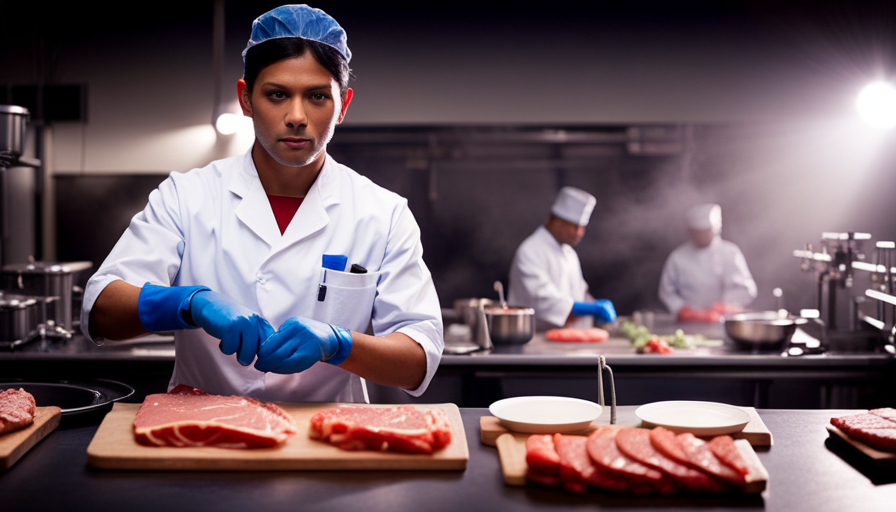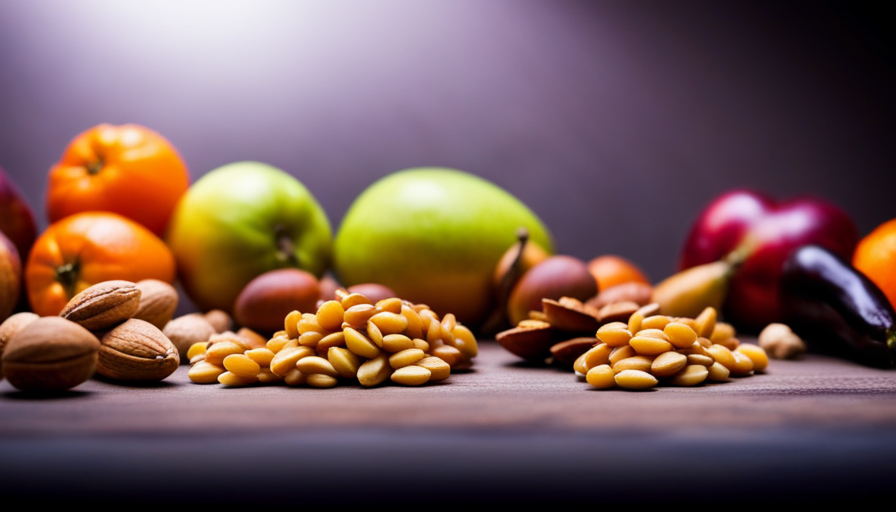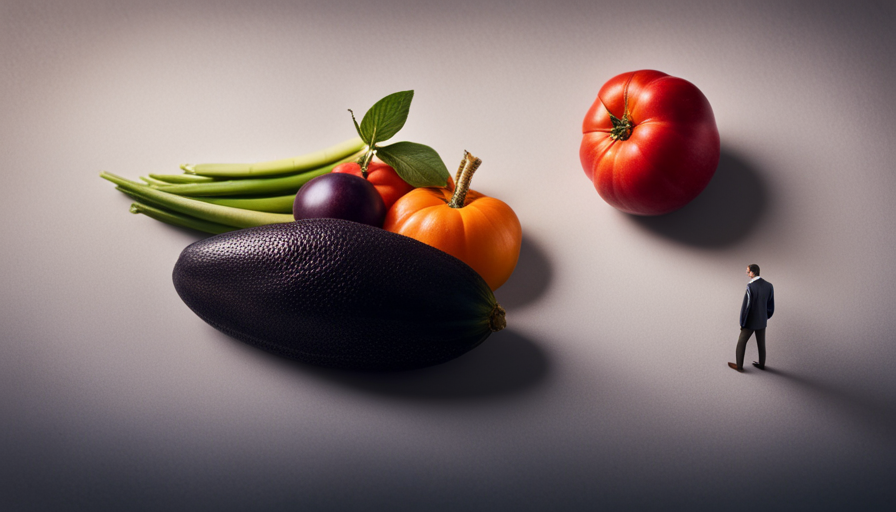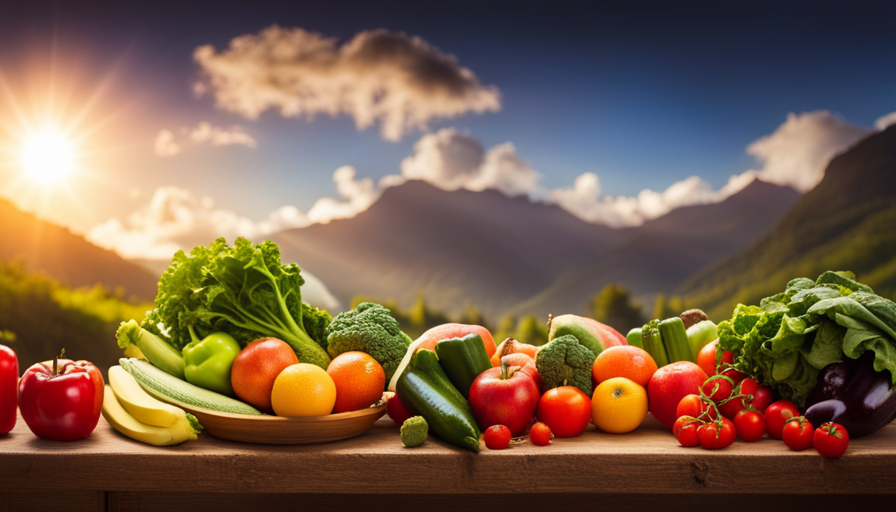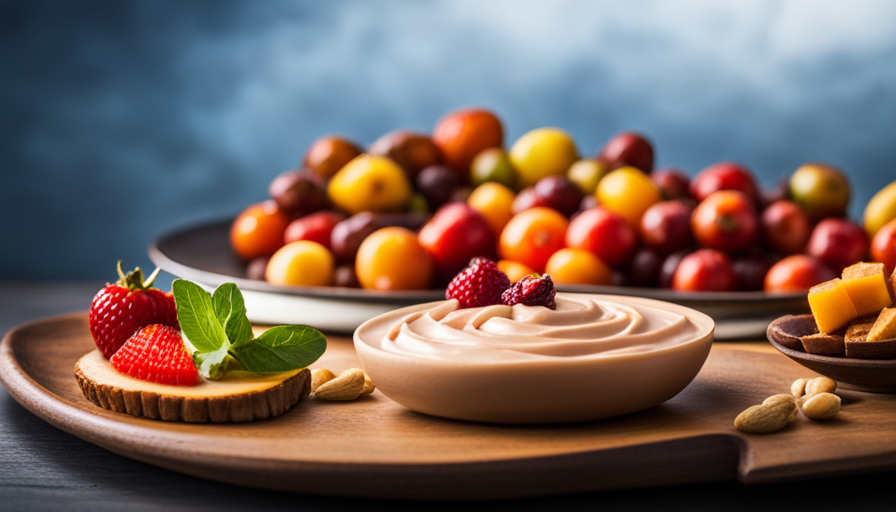When handling raw meat and ready-to-eat food, it is crucial to take necessary precautions to avoid cross-contamination. As a food handler, it is my duty to guarantee that the food I am preparing is safe and does not contain any harmful bacteria or pathogens. To accomplish this, I must adhere to strict protocols and procedures to reduce the chances of cross-contamination.
Ironically, cross-contamination is a silent menace in the kitchen that can go unnoticed, but its consequences can be severe. Imagine serving a delicious meal to your loved ones, only to have it tainted with harmful bacteria that can cause foodborne illnesses. This is why it is crucial for food handlers like me to be diligent and proactive in safeguarding the health and well-being of our customers.
In this article, I will delve into the various measures that food handlers should take to prevent cross-contamination when preparing raw meat and ready-to-eat food. From using separate cutting boards and utensils to washing hands thoroughly and frequently, each step plays a vital role in ensuring the safety of the food we serve.
So, let’s explore these techniques and equip ourselves with the knowledge and skills needed to maintain the highest standards of food safety.
Key Takeaways
- Use separate cutting boards and utensils for raw meat and ready-to-eat food.
- Practice proper hand hygiene, including thorough and frequent handwashing.
- Store raw meat separately, in airtight containers, and follow temperature guidelines.
- Regularly clean and sanitize surfaces, cutting boards, countertops, and high-touch areas.
Use Separate Cutting Boards and Utensils
To prevent cross-contamination, you should always use separate cutting boards and utensils when preparing raw meat and ready-to-eat food. This is an essential step in maintaining proper hygiene and preventing the spread of harmful bacteria.
When you use the same cutting board and utensils for both raw meat and ready-to-eat food, you run the risk of contaminating the latter with any bacteria present in the raw meat. Using separate cutting boards and utensils is crucial because it helps to minimize the transfer of bacteria from raw meat to other foods.
Raw meat can contain harmful pathogens such as Salmonella, E. coli, and Campylobacter, which can cause foodborne illnesses if ingested. By using different cutting boards and utensils, you can effectively prevent the cross-contamination of these pathogens onto ready-to-eat food items.
It’s important to note that using separate cutting boards and utensils alone isn’t enough to ensure food safety. You should also wash your hands thoroughly and frequently. This is because bacteria can easily transfer from your hands to the surfaces you touch, including cutting boards and utensils. By practicing good hand hygiene, you can further reduce the risk of cross-contamination and maintain a safe and hygienic food preparation environment.
Wash Hands Thoroughly and Frequently
Make sure you frequently wash your hands thoroughly to keep everything clean and safe while you’re cooking. Hand hygiene is crucial in preventing cross-contamination and ensuring the safety of your food. By washing your hands frequently and properly, you can help eliminate any harmful bacteria that may be present.
To emphasize the importance of hand hygiene, let’s take a look at the following table:
| Step | Action | Reason |
|---|---|---|
| 1 | Wet your hands with clean, running water. | Ensures the removal of any dirt or debris. |
| 2 | Apply soap and lather well. | Helps to break down and remove bacteria effectively. |
| 3 | Scrub your hands for at least 20 seconds. | Allows time for the soap to work and removes most bacteria. |
| 4 | Rinse your hands thoroughly under running water. | Washes away any remaining soap and bacteria. |
| 5 | Dry your hands using a clean towel or air dryer. | Prevents the recontamination of hands. |
By following these steps, you can maintain proper hand hygiene and reduce the risk of cross-contamination. Remember, clean hands are essential when handling raw meat and ready-to-eat food.
As we move on to the next section about storing ingredients properly, it is important to continue practicing good hygiene to ensure the safety of your meals.
Store Ingredients Properly
Ensure the safety of your ingredients by properly storing them, like carefully tucking them away in the fridge to keep them as fresh as a cool breeze on a sunny day. Proper ingredient storage is crucial to preventing cross-contamination and maintaining the quality of your food. Here are some important guidelines to follow:
-
Separate raw meat from other ingredients: Raw meat should be stored in a separate container, preferably on the bottom shelf of the refrigerator, to prevent any juices from dripping onto ready-to-eat food. This will help avoid the transfer of harmful bacteria.
-
Use airtight containers: Store ingredients in airtight containers to maintain their freshness and prevent any odors from spreading. This will also protect them from any potential contaminants in the refrigerator.
-
Label and date containers: Properly labeling and dating containers will help you keep track of the freshness of your ingredients. This practice ensures that you use them in a timely manner and avoid any potential spoilage.
-
Follow temperature guidelines: Refrigerate perishable ingredients promptly at the recommended temperature to slow down bacterial growth. Keeping the refrigerator temperature at or below 40°F (4°C) is essential to maintaining food safety.
By following these proper ingredient storage practices, you can minimize the risk of cross-contamination and maintain the quality of your food. Next, we’ll discuss how to keep raw meat separate from ready-to-eat food.
Keep Raw Meat Separate from Ready-to-Eat Food
Properly storing ingredients is essential in maintaining food safety and preventing any potential risks associated with handling different types of ingredients. When it comes to preventing cross-contamination, one of the most important practices is keeping raw meat separate from ready-to-eat food. This is crucial because raw meat can contain harmful bacteria that can easily transfer onto other foods, leading to foodborne illnesses.
To emphasize the importance of this practice, let’s take a look at a table that highlights the cross-contamination risks involved:
| Cross-Contamination Risks | Potential Consequences | Importance of Food Safety Training |
|---|---|---|
| Cutting raw meat on a cutting board, then using the same board for ready-to-eat food | Transfer of harmful bacteria | Proper training ensures awareness of cross-contamination risks |
| Storing raw meat above ready-to-eat food in the refrigerator | Drips from raw meat contaminating ready-to-eat food | Training helps in understanding proper storage techniques |
| Using the same utensils for raw meat and ready-to-eat food without proper cleaning | Bacteria transfer onto ready-to-eat food | Knowledge gained through training enables safe handling practices |
As you can see, proper training in food safety is crucial to prevent cross-contamination and protect consumers from potential health risks. By keeping raw meat separate from ready-to-eat food, we can significantly reduce the chances of contamination and keep our customers safe.
In the subsequent section, we will discuss the importance of cleaning and sanitizing surfaces regularly to further ensure food safety.
Clean and Sanitize Surfaces Regularly
Keep your kitchen surfaces clean and sanitized regularly to maintain a safe and hygienic environment for food preparation. To prevent cross-contamination when preparing raw meat and ready-to-eat food, it’s essential to follow proper cleaning techniques.
Here are some important points to consider:
-
Use food-grade sanitizers: It’s crucial to use sanitizers that are specifically designed for use in food preparation areas. These sanitizers are formulated to effectively kill harmful bacteria and viruses, reducing the risk of cross-contamination.
-
Clean and sanitize cutting boards and countertops: After each use, thoroughly clean cutting boards and countertops with hot, soapy water. Rinse them well and then sanitize them using a food-grade sanitizer. This will help eliminate any bacteria or residue that may be present.
-
Pay attention to high-touch areas: Areas such as faucet handles, refrigerator handles, and drawer pulls can harbor harmful bacteria. Make sure to clean and sanitize these areas regularly to prevent the spread of germs.
-
Follow proper cleaning techniques: When cleaning surfaces, remember to scrub them thoroughly to remove any visible dirt or debris. Rinse the surfaces well and then sanitize them according to the instructions on the sanitizer label.
Using food-grade sanitizers and following proper cleaning techniques play a crucial role in preventing cross-contamination in the kitchen. These practices help eliminate harmful bacteria and create a safer environment for food preparation.
Transitioning to the next section, it’s also important to use disposable gloves when handling raw meat to further minimize the risk of cross-contamination.
Use Disposable Gloves when Handling Raw Meat
When handling raw meat, it’s essential to don disposable gloves to maintain a safe and hygienic kitchen environment. Disposable gloves act as a barrier between the food handler’s hands and the raw meat, preventing any potential cross-contamination. They are designed to be single-use and should be discarded after each use to avoid the spread of bacteria.
Using disposable gloves helps reduce the risk of transferring harmful pathogens from raw meat to ready-to-eat food. These gloves are made from materials such as latex, vinyl, or nitrile, which are impermeable to bacteria and other microorganisms. It’s crucial to choose the right size of gloves to ensure a snug fit, allowing for dexterity and minimizing the risk of tearing.
While disposable gloves are the preferred option, there are alternatives available for those with latex allergies or sensitivities. Nitrile gloves, for example, are a suitable alternative as they offer similar protection and are latex-free.
Proper glove usage involves putting on the gloves before handling raw meat and removing them immediately afterwards. It’s important to avoid touching any surfaces or ready-to-eat food while wearing the gloves, as this can lead to cross-contamination.
In the next section on cooking food to appropriate temperatures, we will explore how proper cooking techniques further reduce the risk of foodborne illnesses.
Cook Food to Appropriate Temperatures
To ensure your meal is cooked to perfection, it’s crucial to pay attention to the internal temperature of the food. Did you know that a medium-rare steak should reach a temperature of 135°F (57°C), creating a juicy and tender texture that melts in your mouth? Cooking food to appropriate temperatures is a fundamental aspect of food safety guidelines, as it helps prevent the risk of foodborne illnesses.
Here are some key points to keep in mind:
-
Use a food thermometer: This handy tool is essential for accurately measuring the internal temperature of your food. Insert it into the thickest part of the meat without touching bone or fat.
-
Follow temperature guidelines: Different types of food require specific internal temperatures to be considered safe for consumption. For example, poultry should reach a minimum temperature of 165°F (74°C), while ground meats should reach 160°F (71°C).
-
Allow for resting time: After cooking, let the food rest for a few minutes. This allows the internal temperature to continue rising and ensures any potential bacteria are eliminated.
By cooking food to appropriate temperatures, you can confidently enjoy your meal without worrying about foodborne illnesses. Now, let’s explore how to avoid cross-contamination in storage areas.
Avoid Cross-Contamination in Storage Areas
After ensuring that food is cooked to appropriate temperatures, it’s crucial to address another important aspect of preventing cross-contamination: avoiding cross-contamination in storage areas.
Proper storage organization plays a key role in minimizing the risks associated with cross-contamination.
To begin with, it’s essential to segregate raw meat and ready-to-eat food items in separate storage areas. This separation helps to prevent any potential contact between these two types of food, reducing the chances of cross-contamination. Additionally, it’s important to store raw meat on the lowest shelves to prevent any drips or leaks from contaminating other food items.
Furthermore, maintaining a clean and organized storage area is crucial. Regularly cleaning and sanitizing storage shelves, containers, and utensils helps to eliminate any potential bacteria that may be present. Implementing a proper labeling system for different food items and regularly rotating stock can also help to prevent cross-contamination.
By following these storage practices, food handlers can significantly reduce the risks of cross-contamination in their work environment.
In the subsequent section about educating and training food handlers on safe practices, we’ll explore further steps to enhance their knowledge and skills in maintaining food safety.
Educate and Train Food Handlers on Safe Practices
Ensure that you educate and train yourself on safe practices to protect the health and well-being of your customers and maintain the highest standards of food safety. Proper education and training are essential for food handlers to understand and comply with food safety regulations.
By being knowledgeable about safe practices, you can prevent cross-contamination when preparing raw meat and ready-to-eat food.
To help you better understand the importance of proper training, here are four key points to keep in mind:
-
Awareness of potential hazards: Education and training will teach you about the potential risks and hazards associated with cross-contamination. This knowledge will enable you to take necessary precautions to prevent it.
-
Proper handling techniques: Training will provide you with the necessary skills to handle raw meat and ready-to-eat food safely. You will learn how to use separate utensils, cutting boards, and storage containers to avoid cross-contamination.
-
Personal hygiene practices: Proper training emphasizes the importance of personal hygiene, such as frequent handwashing and wearing protective clothing, to prevent the spread of bacteria and other contaminants.
-
Understanding regulations: Education on food safety regulations ensures that you are aware of the specific guidelines and requirements that must be followed in your establishment.
By educating and training yourself on safe practices, you can maintain a high level of food safety and protect the health of your customers.
It is important to regularly monitor and enforce compliance with guidelines to ensure continued adherence to safe practices.
Regularly Monitor and Enforce Compliance with Guidelines
Make sure you regularly monitor and enforce compliance with guidelines to ensure the highest level of food safety and protect the well-being of your customers. Monitoring compliance is essential in preventing cross-contamination when preparing raw meat and ready-to-eat food. It involves actively observing and evaluating food handlers’ practices to ensure they’re following the established guidelines.
Regular monitoring allows for early detection of any deviations from safe practices, giving you the opportunity to correct them promptly. To effectively monitor compliance, establish a system that includes regular inspections and observations. Conduct routine checks of food handling areas, such as kitchens and preparation stations, to assess cleanliness and adherence to proper procedures. Observe food handlers during their tasks to ensure they’re using separate utensils, cutting boards, and equipment for raw meat and ready-to-eat food. Additionally, verify that they’re washing their hands frequently and wearing appropriate protective gear, such as gloves and hairnets.
Enforcing guidelines is equally important. This involves taking corrective actions when non-compliance is identified. Provide immediate feedback to food handlers if any deviations are observed. Reinforce the importance of following guidelines and explain the potential risks associated with cross-contamination. Implement disciplinary measures if necessary to ensure compliance in the future.
By regularly monitoring compliance and enforcing guidelines, you can create a culture of food safety and prevent cross-contamination in your establishment. This not only protects the health and well-being of your customers but also maintains your reputation as a responsible and trustworthy food service provider.
Frequently Asked Questions
How can cross-contamination be prevented in storage areas?
To prevent cross-contamination in storage areas, proper storage organization and handling techniques are crucial. One interesting statistic to consider is that, according to a study conducted by the Food and Drug Administration, improper storage and handling of food contributes to approximately 48 million cases of foodborne illnesses in the United States each year.
To minimize the risk, it’s essential to store raw meat separately from ready-to-eat foods and ensure that they’re stored at appropriate temperatures to prevent bacterial growth.
Additionally, regularly cleaning and sanitizing storage areas can further reduce the chances of cross-contamination.
What are the appropriate temperatures for cooking food to ensure safety?
Appropriate cooking temperatures are crucial for ensuring food safety. It is important to cook food thoroughly to kill harmful bacteria and prevent foodborne illnesses.
Different types of food require specific internal temperatures to be considered safe. For example, poultry should be cooked to an internal temperature of 165°F (74°C), while ground meats should reach 160°F (71°C).
It is essential to use a food thermometer to accurately measure the temperature and ensure that the food is cooked to the appropriate level of doneness.
Why is it important to educate and train food handlers on safe practices?
It’s important to educate and train food handlers on safe practices because it ensures that they have the necessary knowledge and skills to prevent foodborne illnesses. Through educational resources and training programs, food handlers learn about proper hygiene practices, safe food storage, and the importance of cross-contamination prevention.
They also gain an understanding of the potential hazards associated with food handling and how to mitigate them. This ultimately helps protect the health and well-being of consumers and maintains the reputation of food establishments.
How often should surfaces be cleaned and sanitized to prevent cross-contamination?
Surfaces should be cleaned and sanitized regularly to prevent cross-contamination. The frequency of surface cleaning depends on the specific food handling environment and the level of risk. To ensure thorough cleaning, surfaces should be cleaned and sanitized at least every 4 hours or more frequently if necessary.
It’s important to use appropriate cleaning agents and follow proper techniques to effectively remove any potential contaminants. Regular surface cleaning is a crucial step in maintaining food safety and preventing the spread of harmful bacteria.
What are the potential risks of not enforcing compliance with guidelines for preventing cross-contamination?
The potential consequences of not enforcing compliance with guidelines for preventing cross-contamination are severe. Without proper training, there’s a heightened risk of harmful bacteria spreading, leading to foodborne illnesses. These illnesses can range from mild discomfort to life-threatening conditions.
Additionally, there’s a risk of tarnishing the reputation of the establishment, resulting in financial losses and legal repercussions. It’s crucial to prioritize the importance of proper training to ensure the safety of both consumers and the business.
How can a food handler prevent cross-contamination while using marinade for raw meat?
When handling raw meat and using marinade, it’s crucial to follow food safety guidelines for marinade to prevent cross-contamination. Use separate containers and utensils for marinating raw meat, and never reuse marinade that has come into contact with raw meat. This simple practice can help prevent foodborne illnesses.
Conclusion
In conclusion, it’s absolutely crucial for food handlers to take the necessary steps to prevent cross-contamination when preparing raw meat and ready-to-eat food.
By using separate cutting boards and utensils, washing hands thoroughly and frequently, storing ingredients properly, and keeping raw meat separate from ready-to-eat food, we can ensure the safety and well-being of our customers.
Additionally, cleaning and sanitizing surfaces regularly, cooking food to appropriate temperatures, avoiding cross-contamination in storage areas, and educating and training food handlers on safe practices are all important measures to prevent cross-contamination.
It is our responsibility to regularly monitor and enforce compliance with these guidelines to maintain the highest standards of food safety.

